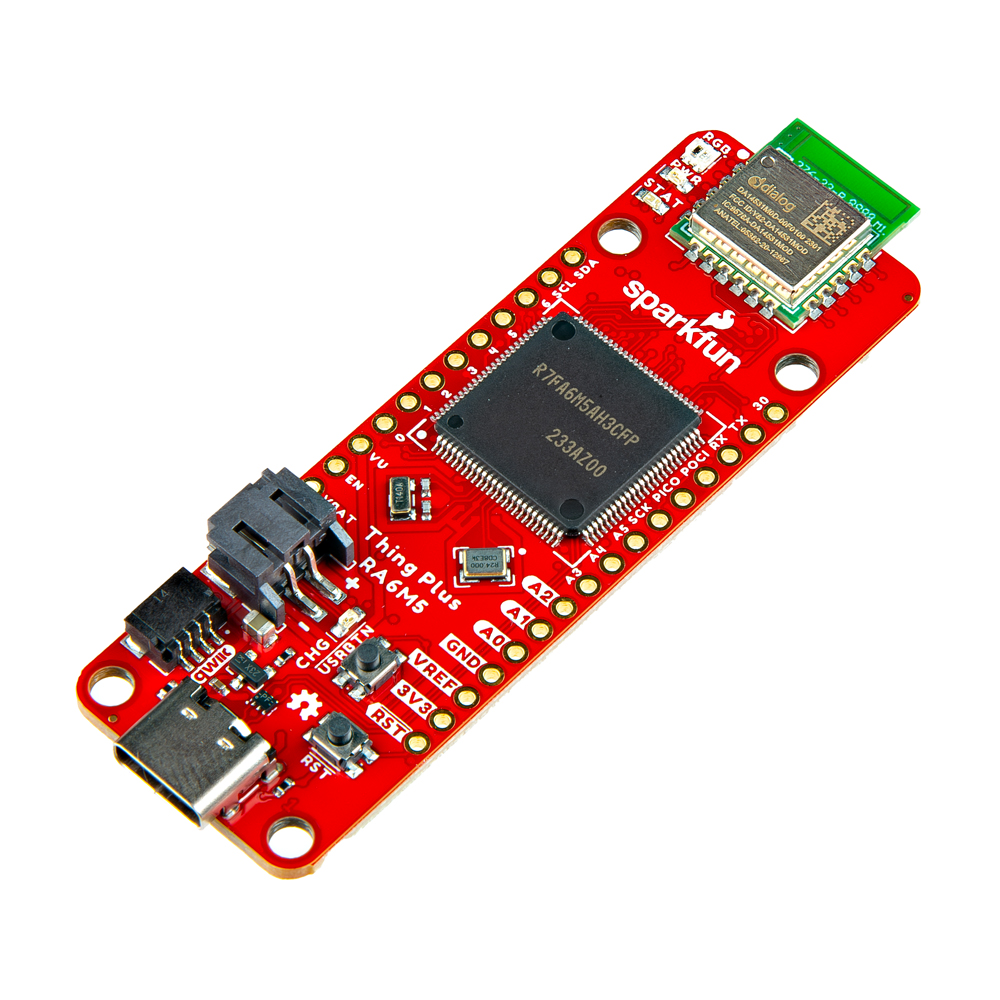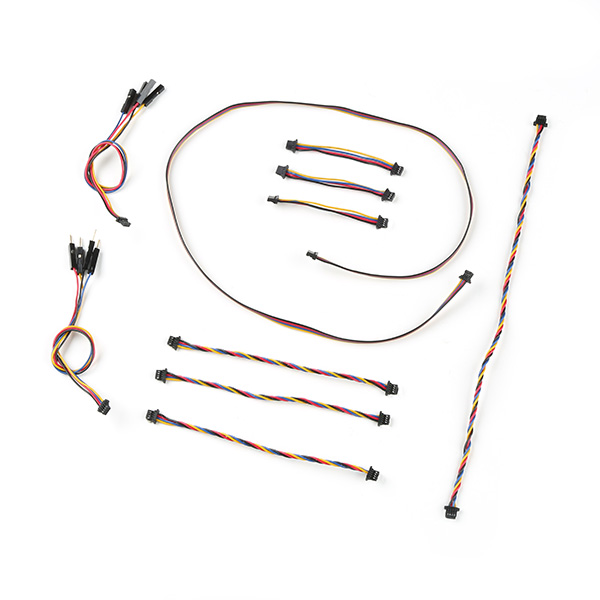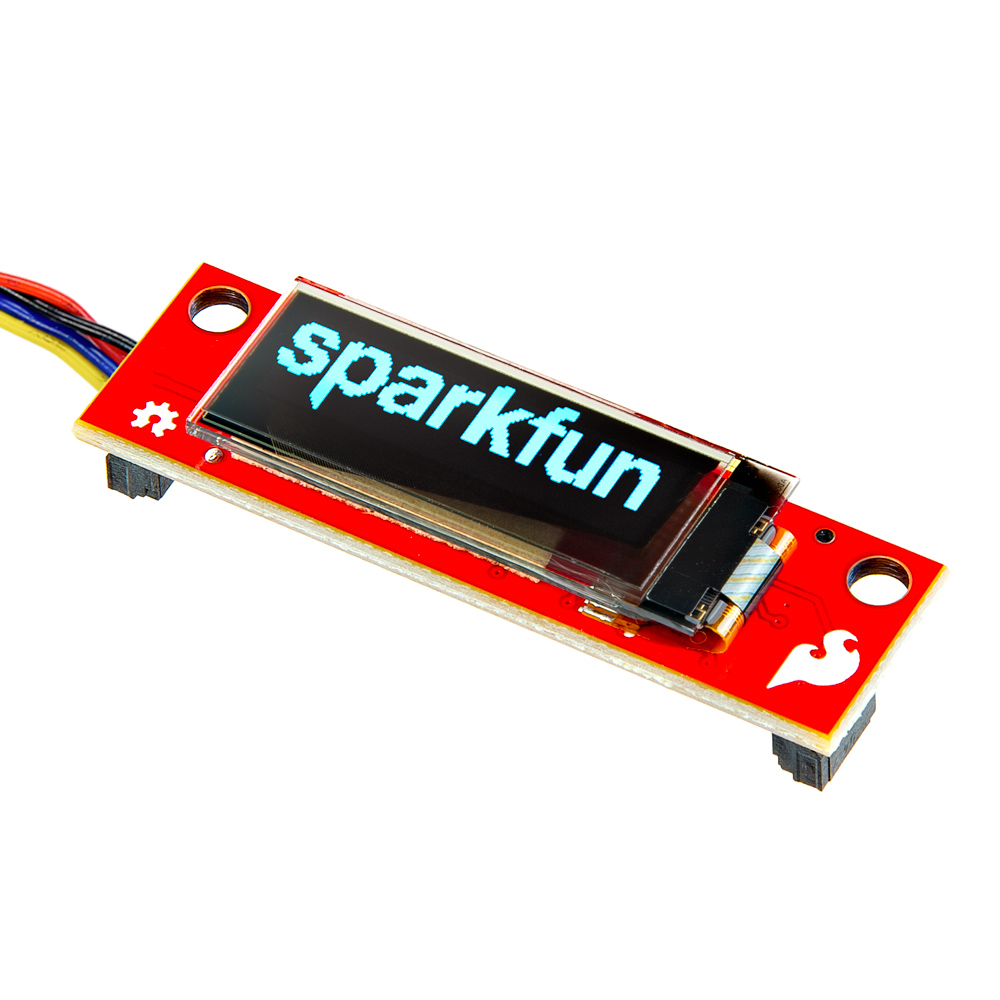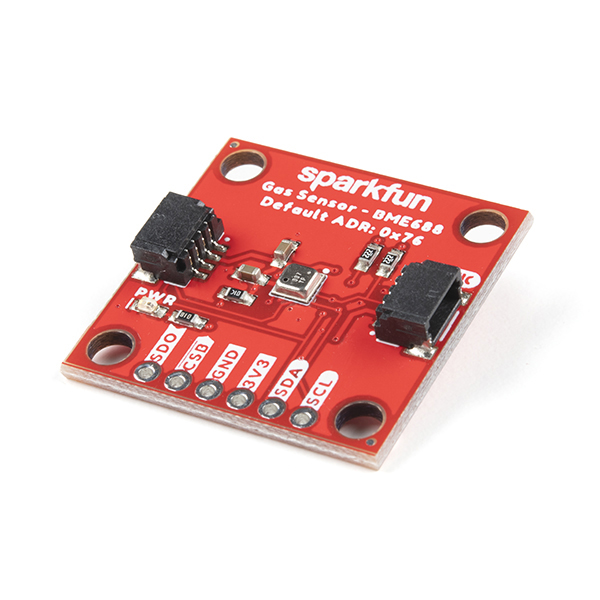| icon |
|---|
material/bluetooth |
To help users get started with the CodeLess™ AT commands for the DA14531MOD Bluetooth module, we have provided an SerialPassthrough example in our unofficial Arduino library. Once programmed on the RA6M5 Thing Plus, the example allows users to directly interface with the DA14531MOD's UART port through the board's USB connection using a serial terminal. Thereby, enabling users to experiment with the CodeLess AT commands and develop their own BLE connectivity solution. Users can find this sketch in the File > Examples > SparkFun Renesas Codeless BLE > SerialPassthrough drop-down menu.
??? code "SerialPassthrough.ino"
cpp --8<-- "https://raw.githubusercontent.com/sparkfun/SparkFun_Thing_Plus_RA6M5/main/Firmware/CodelessBLE/examples/SerialPassthrough/SerialPassthrough.ino"
!!! serial "Serial Monitor" Users should configure the serial port with a baud rate at 57600 bps and enable the carriage return on the transmissions.
While an Arduino library isn't necessary to utilize the CodeLess™ AT commands for the DA14531MOD Bluetooth module, we have created an unofficial Arduino library to help users get started. Once the library is installed in the Arduino IDE, users will find several example sketches listed in the File > Examples > SparkFun Renesas Codeless BLE drop-down menu. We recommend users check out the following examples that demonstrate a basic BLE connectivity solution:
codelessBLE_peripheral.inocodelessBLE_central.ino
In order to operate the codelessBLE_peripheral.ino and codelessBLE_central.ino examples, users will need two RA6M5 Thing Plus boards, Qwiic OLED Display, Qwiic BME280 sensor, and some Qwiic cables.
??? note "Required Hardware"
- <a href="https://www.sparkfun.com/products/24243">
<figure markdown>

</figure>
---
**RA6M5 Thing Plus**<br>
WRL-24243</a>
- <a href="https://www.sparkfun.com/products/15081">
<figure markdown>

</figure>
---
**SparkFun Qwiic Cable Kit**<br>
KIT-15081</a>
- <a href="https://www.sparkfun.com/products/24606">
<figure markdown>

</figure>
---
**SparkFun Qwiic OLED Display (0.91 in., 128x32)**<br>
LCD-24606</a>
- <a href="https://www.sparkfun.com/products/15440">
<figure markdown>

</figure>
---
**SparkFun Atmospheric Sensor Breakout - BME280 (Qwiic)**<br>
SEN-15440</a>
</div>
=== "codelessBLE_peripheral.ino"
This sketch requires a Qwiic BME280 sensor, connected by a Qwiic cable, to be connected the RA6M5 Thing Plus. The sketch demonstrates a basic BLE solution, by transmitting data from the BME280 to another BLE device. Users can find this sketch in the File > Examples > SparkFun Renesas Codeless BLE > codelessBLE_peripheral drop-down menu.
??? arduino "Install Arduino Library"
For this example, the [SparkFun BME280 Arduino Library](https://github.com/sparkfun/SparkFun_BME280_Arduino_Library) will need to be installed. In the Arduino IDE, users can install it by searching for `SparkFun BME280 Arduino Library`, in the **Library Manager**:
SparkFun BME280 Arduino Library
??? code "`codelessBLE_peripheral.ino`"
```cpp
--8<-- "https://raw.githubusercontent.com/sparkfun/SparkFun_Thing_Plus_RA6M5/main/Firmware/CodelessBLE/examples/codelessBLE_peripheral/codelessBLE_peripheral.ino"
```
!!! tip "BME688 Replacement"
Users can also modify this example to utilize the [Qwiic BME688 sensor](https://www.sparkfun.com/products/19096) that is mentioned in some of the other examples. *For more details on utilizing the BME68x breakout board, please refer to our [hookup guide](https://learn.sparkfun.com/tutorials/1168) for the sensor.*
<div class="grid cards" markdown>
- <a href="https://www.sparkfun.com/products/19096">
<figure markdown>

</figure>
---
**SparkFun Environmental Sensor - BME688 (Qwiic)**<br>
SEN-19096</a>
- <a href="https://www.sparkfun.com/products/17260">
<figure markdown>

</figure>
---
**Flexible Qwiic Cable - 50mm**<br>
PRT-17260</a>
</div>
??? arduino "Install Arduino Library"
Users will need to install the [Bosch BME68x Arduino library](https://github.com/BoschSensortec/Bosch-BME68x-Library) for the sensor. In the Arduino IDE, users can install it by searching for `BME68x Sensor Library`, in the **Library Manager**:
BME68x Sensor Library
??? code "Modifications"
- Link the BME68x Arduino library:
{--#include "SparkFunBME280.h"--}
{++#include "bme68xLibrary.h"++}
- Create an instance of the `Bme68x` class:
{--BME280 myBME280;--}
{++Bme68x bme;++}
- Initialize and configure the sensor in the `setup()`:
{--if(!myBME280.beginI2C())
{
Serial.println("Sensor didn't respond. Check wiring!");
while(1);
}
Serial.println("Connected to BME280.");--}
{++bme.begin(BME68X_I2C_ADDR_LOW, Wire);
if(bme.checkStatus())
{
if (bme.checkStatus() == BME68X_ERROR)
{
Serial.println("Sensor error:" + bme.statusString());
return;
}
else if (bme.checkStatus() == BME68X_WARNING)
{
Serial.println("Sensor Warning:" + bme.statusString());
}
}
/* Set the default configuration for temperature, pressure and humidity */
bme.setTPH();
/* Configure the sensor to forced mode */
bme.setOpMode(BME68X_FORCED_MODE);++}
- Update the `loop()` to retrieve data from the BME688
{--if((loop_start_time - millis()) > 100) // If it's been more than 100ms
{
reset_loop = true;
if(bleConnected)
{
digitalWrite(LED_BUILTIN, HIGH);
printstring = "|"+String(myBME280.readTempC())+","+String(myBME280.readFloatHumidity())+","+String(myBME280.readFloatPressure());
Serial.println(myBLEPeripheral.sendCommand(printstring));
digitalWrite(LED_BUILTIN, LOW);
}--}
{++bme68xData data;
if((loop_start_time - millis()) > 100) // If it's been more than 100ms
{
reset_loop = true;
if(bleConnected)
{
digitalWrite(LED_BUILTIN, HIGH);
delayMicroseconds(bme.getMeasDur()); // Wait for measurement data
/* Retrieve data from BME688 sensor*/
if (bme.fetchData())
{
bme.getData(data);
printstring = "|"+String(data.temperature)+","+String(data.humidity)+","+String(data.pressure);
}
Serial.print(myBLEPeripheral.sendCommand(printstring));
digitalWrite(LED_BUILTIN, LOW);
}++}
=== "codelessBLE_central.ino"
This sketch requires a Qwiic OLED Display to be connected the RA6M5 Thing Plus, by a Qwiic cable. The sketch receives data transmitted from a RA6M5 Thing Plus, programmed with the codelessBLE_peripheral.ino sketch, and displays that data on the OLED display. Users can find this sketch in the File > Examples > SparkFun Renesas Codeless BLE > codelessBLE_central drop-down menu.
??? code "`codelessBLE_central.ino`"
```cpp
--8<-- "https://raw.githubusercontent.com/sparkfun/SparkFun_Thing_Plus_RA6M5/main/Firmware/CodelessBLE/examples/codelessBLE_central/codelessBLE_central.ino"
```